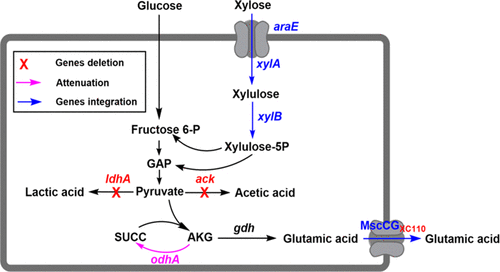当前位置:
X-MOL 学术
›
ACS Sustain. Chem. Eng.
›
论文详情
Our official English website, www.x-mol.net, welcomes your
feedback! (Note: you will need to create a separate account there.)
High-Titer Glutamic Acid Production from Lignocellulose Using an Engineered Corynebacterium glutamicum with Simultaneous Co-utilization of Xylose and Glucose
ACS Sustainable Chemistry & Engineering ( IF 7.1 ) Pub Date : 2020-04-16 , DOI: 10.1021/acssuschemeng.9b07839 Ci Jin 1 , Zhen Huang 1 , Jie Bao 1
ACS Sustainable Chemistry & Engineering ( IF 7.1 ) Pub Date : 2020-04-16 , DOI: 10.1021/acssuschemeng.9b07839 Ci Jin 1 , Zhen Huang 1 , Jie Bao 1
Affiliation

|
Xylose utilization by Corynebacterium glutamicum is an essential but unresolved issue in glutamic acid production from lignocellulose biomass. Coexistence of xylose with inhibitors requires a selective removal of inhibitors while the xylose is still well retained in the pretreated lignocellulose feedstock. Not only is xylose assimilation in C. glutamicum at low efficiency, but also there are unique challenges, which eliminate the generation of glutamic acid from xylose when lignocellulose is used. There include excessive biotin content in lignocellulose blocking intracellular secretion of glutamic acid, complicated organic acid generation pathways decreasing the glutamic acid conversion yield from xylose, and transmembrane resistance of xylose limiting the xylose utilization efficiency. Here, we applied a unique biodetoxification on pretreated wheat straw solids, which resulted in a complete removal of inhibitors and a high conservation of xylose sugar. The major focus of the study is a stepwise metabolic engineering of C. glutamicum to trigger high-titer glutamate production by coordinated assimilation of xylose and glucose from a typical lignocellulosic sugar. First, the secretion channel protein MscCG was modified to initiate glutamic acid secretion in biotin-rich environments from almost zero glutamic acid accumulation. Next, the byproduct generation pathways of lactate, acetate, and succinate were knocked out or attenuated to redirect carbon flux to glutamic acid accumulation. Further overexpression of the pentose transporter gene araE increased the xylose utilization rate and glutamic acid production. The finally obtained C. glutamicum GJ04 produced 39.8 g/L of glutamate from 60.3 g/L of glucose and 38.8 g/L of xylose in synthetic medium and produced 61.7 g/L of glutamate from 116.1 g/L of glucose and 39.6 g/L of xylose using wheat straw feedstock. This is the first example of the practical utilization of lignocellulose-derived xylose and glucose for cellulosic glutamic acid production.
中文翻译:

使用工程改造的谷氨酸棒杆菌同时木屑和葡萄糖的联合利用,从木质纤维素生产高滴度谷氨酸
谷氨酸棒杆菌对木糖的利用是从木质纤维素生物质生产谷氨酸的重要但未解决的问题。木糖与抑制剂的共存要求选择性除去抑制剂,而木糖仍很好地保留在预处理的木质纤维素原料中。谷氨酸棒杆菌中的木糖同化不仅在低效率下,还存在独特的挑战,即消除了使用木质纤维素时木糖产生谷氨酸的问题。木素纤维素中过多的生物素含量会阻止谷氨酸的细胞内分泌,复杂的有机酸生成途径会降低木糖的谷氨酸转化率,木糖的跨膜抗性会限制木糖的利用效率。在这里,我们对预处理过的小麦秸秆固体进行了独特的生物解毒,这导致抑制剂的完全去除和木糖的高度保存。该研究的主要重点是谷氨酸棒杆菌的逐步代谢工程通过协调消化来自典型木质纤维素糖的木糖和葡萄糖来触发高滴度谷氨酸的生产。首先,对分泌通道蛋白MscCG进行修饰,以从几乎零的谷氨酸积累开始在富含生物素的环境中引发谷氨酸分泌。接下来,敲除或减弱乳酸,乙酸盐和琥珀酸盐的副产物生成途径,以将碳通量重定向至谷氨酸的积累。戊糖转运蛋白基因araE的进一步过表达提高了木糖利用率和谷氨酸产量。最终获得的谷氨酸棒杆菌GJ04用小麦秸秆在合成培养基中由60.3 g / L葡萄糖和38.8 g / L木糖生产39.8 g / L谷氨酸,并由116.1 g / L葡萄糖和39.6 g / L木糖生产61.7 g / L谷氨酸。原料。这是将木质纤维素衍生的木糖和葡萄糖实际用于纤维素谷氨酸生产的第一个例子。
更新日期:2020-04-23
中文翻译:

使用工程改造的谷氨酸棒杆菌同时木屑和葡萄糖的联合利用,从木质纤维素生产高滴度谷氨酸
谷氨酸棒杆菌对木糖的利用是从木质纤维素生物质生产谷氨酸的重要但未解决的问题。木糖与抑制剂的共存要求选择性除去抑制剂,而木糖仍很好地保留在预处理的木质纤维素原料中。谷氨酸棒杆菌中的木糖同化不仅在低效率下,还存在独特的挑战,即消除了使用木质纤维素时木糖产生谷氨酸的问题。木素纤维素中过多的生物素含量会阻止谷氨酸的细胞内分泌,复杂的有机酸生成途径会降低木糖的谷氨酸转化率,木糖的跨膜抗性会限制木糖的利用效率。在这里,我们对预处理过的小麦秸秆固体进行了独特的生物解毒,这导致抑制剂的完全去除和木糖的高度保存。该研究的主要重点是谷氨酸棒杆菌的逐步代谢工程通过协调消化来自典型木质纤维素糖的木糖和葡萄糖来触发高滴度谷氨酸的生产。首先,对分泌通道蛋白MscCG进行修饰,以从几乎零的谷氨酸积累开始在富含生物素的环境中引发谷氨酸分泌。接下来,敲除或减弱乳酸,乙酸盐和琥珀酸盐的副产物生成途径,以将碳通量重定向至谷氨酸的积累。戊糖转运蛋白基因araE的进一步过表达提高了木糖利用率和谷氨酸产量。最终获得的谷氨酸棒杆菌GJ04用小麦秸秆在合成培养基中由60.3 g / L葡萄糖和38.8 g / L木糖生产39.8 g / L谷氨酸,并由116.1 g / L葡萄糖和39.6 g / L木糖生产61.7 g / L谷氨酸。原料。这是将木质纤维素衍生的木糖和葡萄糖实际用于纤维素谷氨酸生产的第一个例子。











































 京公网安备 11010802027423号
京公网安备 11010802027423号